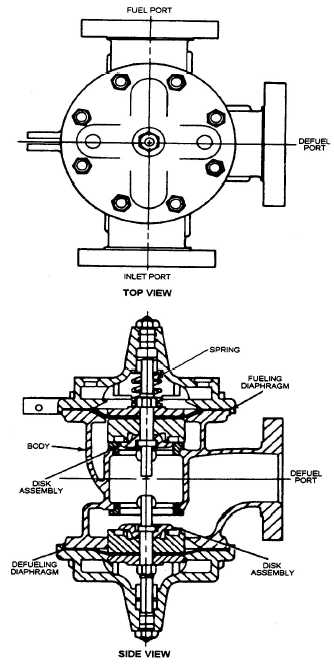Main Fuel/Defuel Valve
The main valve (fig. 5-2) is actually two single-
seated globe valves built into a common body. Each of
the valves performs a separate and distinct function,
one is the fueling valve and the other is the defueling
valve.
Each valve employs a well-supported and
reinforced diaphragm as its operating means. The
Figure 5-2.—Main valve.
fueling valve is spring-loaded to close; therefore, it is
normally closed. The defuel valve is inverted (upside
down) and held open by its own weight.
The main valve directs fuel flow from the inlet
port to the fuel port when fueling, and fuel flow from
the fuel port to the defuel port when defueling. The
fuel and defuel valves are controlled by pressure
acting on a diaphragm. The change from the fuel to
defuel mode is accomplished by energizing or
deenergizing the solenoid-operated pilot valve
(SOPV), or by excessive delivery pressure.
When pressure above the fueling valve
diaphragm is vented off, inlet pressure on the
diaphragm lifts its disk assembly, opening the fuel
valve. Simultaneously, pressure is applied to the
bottom of the defueling valve diaphragm, seating its
disk assembly and closing the defuel valve.
When pressure underneath the defueling valve
diaphragm is vented off, its disk assembly falls, and
the defuel valve opens. Simultaneously, pressure is
applied to the top of the fuel valve diaphragm (both
line and spring). When this pressure overcomes the
inlet pressure, its disk assembly seats, closing the
fuel valve.
The main valve is controlled by a set of smaller
valves using line pressure, thus providing fully
automatic operations. The SOPV shifts the Cla-Val
assembly from defueling to fueling, and from fueling
to defueling. The flow control valve regulates the
opening speed of the fueling side of the main valve.
The hytrol valve either isolates inlet pressure from
the pressure-reducing control valve, or vents inlet
pressure to the pressure-reducing control valve and
the fuel port of the main valve. The pressure-
reducing control valve regulates delivery pressure.
The ejector-strainer aids in relieving pressure above
the diaphragm of the fueling valve and prevents
foreign particles from entering the pressure-reducing
control valve. The pressure relief control valves open
to shift to the defueling mode if the delivery pressure
exceeds the preset limit.
Pressure Relief Control
Valves
The pressure relief control valves (fig. 5-3) open
to shift the main valve to the defueling mode when
delivery pressure exceeds the preset adjustment.
There are two pressure-relief control valves for each
Cla-Val fueling unit. One valve acts as a pressure
5-2

